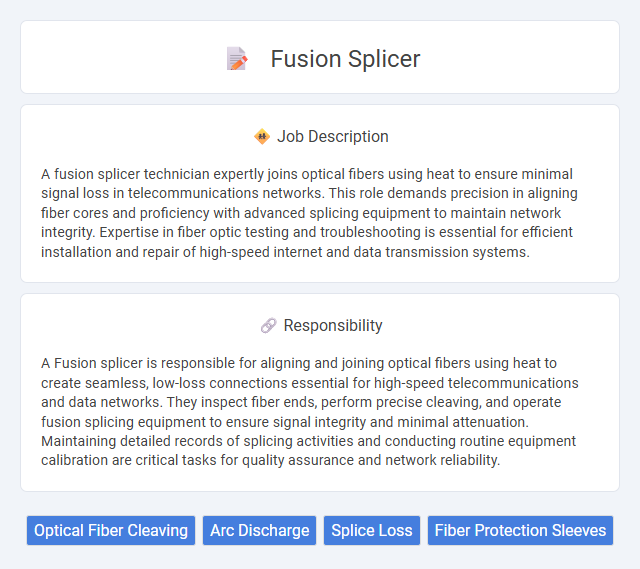
A fusion splicer technician expertly joins optical fibers using heat to ensure minimal signal loss in telecommunications networks. This role demands precision in aligning fiber cores and proficiency with advanced splicing equipment to maintain network integrity. Expertise in fiber optic testing and troubleshooting is essential for efficient installation and repair of high-speed internet and data transmission systems.
People with strong hand-eye coordination and patience are likely to be well-suited for a fusion splicer job, as the role demands precise manipulation of delicate fiber optic cables. Candidates who can maintain focus in potentially confined or challenging work environments may find this job more fitting. Those who are uncomfortable with meticulous, repetitive tasks or working in variable field conditions might find the role less suitable.
Qualification
A fusion splicer must possess technical qualifications including a high school diploma or equivalent, along with specialized training in fiber optic technology and splicing techniques. Certification from recognized bodies such as the Fiber Optic Association (FOA) enhances job prospects by validating skills in cable preparation, alignment, and fusion splicing. Proficiency in interpreting technical schematics and using precision splicing equipment is essential for ensuring high-quality optical fiber connections in telecommunications and data networks.
Responsibility
A Fusion splicer is responsible for aligning and joining optical fibers using heat to create seamless, low-loss connections essential for high-speed telecommunications and data networks. They inspect fiber ends, perform precise cleaving, and operate fusion splicing equipment to ensure signal integrity and minimal attenuation. Maintaining detailed records of splicing activities and conducting routine equipment calibration are critical tasks for quality assurance and network reliability.
Benefit
A fusion splicer job likely offers the benefit of high demand due to the growing need for fiber optic connectivity in telecommunications and data networks. This role probably provides opportunities for specialized skill development, enhancing career advancement prospects. Competitive salaries and job stability could also be expected as fiber optic technology continues to expand globally.
Challenge
Working as a fusion splicer likely presents challenges related to precision and environmental conditions. The probability of encountering difficulties in aligning fibers or managing unexpected interruptions during splicing tasks is relatively high. Success in this role often depends on meticulous attention to detail and adaptability to varying field environments.
Career Advancement
Mastering fusion splicing techniques unlocks opportunities for specialization in fiber optic network installation, maintenance, and troubleshooting roles. Proficiency with advanced equipment and certifications, such as Certified Fiber Optic Technician (CFOT), enhances job prospects and potential for supervisory or project management positions. Career advancement in fiber optics often leads to higher salaries, increased responsibilities, and involvement in large-scale telecommunications infrastructure projects.
Key Terms
Optical Fiber Cleaving
Optical fiber cleaving is a critical step in the fusion splicing process, ensuring a clean, precise cut to achieve low splice loss and high mechanical strength. Proper cleaving techniques involve using a high-quality cleaver to produce a flat, perpendicular fiber end face with minimal defects or angles. Accurate cleaving directly impacts the splice quality, optimizing signal transmission efficiency in fiber optic networks.
Arc Discharge
Fusion splicer technicians specialize in joining optical fibers by precisely aligning and fusing them with an electric arc discharge, ensuring minimal signal loss and maximum fiber strength. The arc discharge generates controlled heat that melts the fiber ends, creating a seamless optical connection critical for high-speed communication networks. Mastery of arc discharge parameters, such as temperature and duration, is essential for producing reliable fiber optic joints in telecommunications and data transmission industries.
Splice Loss
A fusion splicer specialist expertly aligns and welds optical fibers to minimize splice loss, ensuring optimal signal transmission in fiber optic networks. Precision in fiber preparation, alignment, and cleaving directly impacts splice loss, typically measured in decibels (dB), with industry standards aiming for loss values below 0.1 dB per splice. Consistent monitoring and fine-tuning during the splicing process reduce attenuation and back reflection, enhancing overall network performance and reliability.
Fiber Protection Sleeves
Fiber Protection Sleeves are essential components in a fusion splicer's job, ensuring the integrity and durability of fiber optic splices. These sleeves provide mechanical protection and environmental sealing for the delicate fiber joints, preventing breakage and signal loss. Proper application of fusion splicer sleeves enhances overall network reliability by maintaining optimal optical performance and minimizing downtime.
 kuljobs.com
kuljobs.com